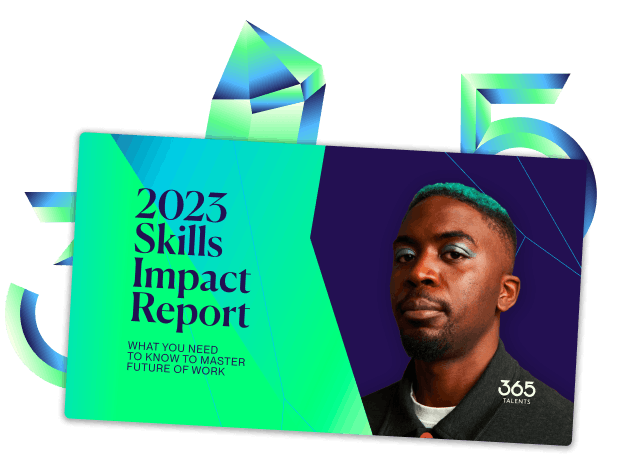Green skills and 7 more must-know HR trends for 2023

The festive season feels like a distant memory, and we’ve almost beaten the January blues; perhaps it’s the perfect time to look to the year ahead and consider the innovations, trends, and challenges that will keep HR teams busy in the coming months.
At the top of our list for 2023 is green skills, but we also think gamification, human leadership, and the metaverse will be at the front of mind for HR professionals across the globe.
1. Green skills
In 2022, record-breaking heat waves, severe droughts, and catastrophic flooding highlighted the need for more drastic climate action.
The world of work plays a critical role in the fight against climate change, whether it’s reducing dependency on fossil fuels, implementing climate-friendly business practices, or doubling down on digital transformation efforts. But to achieve these goals and accelerate the transition to a more sustainable, circular economy, organizations must invest in their green skills.
Green skills are defined as “the knowledge, abilities, values, and attitudes needed to live in, develop, and support a sustainable and resource-efficient society.” When employers invest in these skills, they stand to future-proof their workforce and gain a competitive advantage.
That’s because the Green Economy will create a range of jobs that demand a highly specific skill set. To give just one example, the United Nations estimates that per million US$ of expenditure, the renewable energy sector will create up to 70% more jobs than the fossil-fuelled energy sector.
At the same time, the shift to a circular economy could see the loss of 71 million jobs across the globe. Green-skilled employees may benefit from better job security and increased employment options, while also offering their employers an excellent return on investment .
In addition, focusing on green skills development can serve to attract top talent, since customers and prospective employees increasingly concern themselves with the ethics of the brands they support.
Organizations can succeed in this area by:
- Mapping their green skills requirements
- Reskilling and up-skilling existing employees
- Hiring for green skills and
- Putting sustainability at the heart of their brand proposition


2023 Skills Impact Report
This report, which features original insights from Accenture, Axa Climate School, Credit Agricole, OpenClassrooms and OpenWeb, takes a deep dive into the impact of adopting a skills-based approach to your HR strategy and explores the myriad ways it can transform your organization and help you move quickly and purposefully toward the future.

2. Gamification
Gamification in HR, which includes the use of leaderboards, points and reward systems, quizzes, badges, and (of course) online games, is designed to boost employee and candidate engagement.
While the concept was first introduced in 2003, its popularity has skyrocketed in recent years and the global gamification market is projected to reach $30.7 billion by 2025.
Gamification provides benefits in several key areas:
- Absenteeism: When the most mundane aspects of work are made fun, employees are more motivated and more engaged. As many as 88% of workers said gamification positively impacts their happiness and productivity.
- Candidate experience: Research shows that gamification during the recruitment process makes employers more attractive.
- Retention: Feeling undervalued and under-appreciated is one of the top reasons people quit. Gamification addresses this by providing employees with instant and ongoing reward and recognition.
- Learning and development: Gamification enables employees to quickly acquire skills and absorb new information. They’ll be more engaged, more compliant, and more motivated to succeed.
3. The metaverse
The metaverse is a collective virtual shared space that leverages virtual reality (VR), augmented reality (AR), and other advanced internet and semiconductor technologies to create immersive alternate worlds.
It looks set to be one of the biggest trends for 2023, with Gartner predicting that 25% of people will spend at least an hour daily in the metaverse by 2026.
The metaverse presents opportunities for HR teams to connect more meaningfully with job candidates across the globe, whether it’s hosting virtual recruitment fairs, onboarding new hires, or building a more equitable workplace.
Re-imagining workspaces to drive productivity, collaboration, and creativity will also be possible since the metaverse will enable HR professionals to circumvent the constraints of a physical workplace.
To prepare for the rise of the metaverse in the coming months and years, HR leaders must:
- Create effective hybrid working policies
- Implement rigorous training programs to ensure employees can work and lead effectively in these new environments
- Establishing robust data security systems
- Recruit people with mixed-reality technology experience
- Gather suggestions from employees on how they would like to experience the metaverse.
4. Curbing burnout and talent loss
In 2021, the Great Resignation saw 47.8 million Americans quit their jobs, most often in search of a more meaningful existence.
Some months later, it was reported that the Great Resignation was morphing into the Great Reshuffle since workers were opting to switch roles (and companies), instead of abandoning the workforce altogether.
More recently, in September 2022, the “quiet quitting” movement grew momentum. In a backlash to “hustle culture” employees in their thousands vowed to stop “going above and beyond” in their roles and do nothing more than their required duties.
In October of the same year, the Great Breakup saw women leaders leaving their companies in record numbers. According to a report released by McKinsey and LeanIn.Org, for every director-level woman promoted to the next business level, two female directors are resigning.
If organizations want to hold on to their top talent in 2023, promoting employee well-being and curbing burnout must be a top priority. The American Institute of Stress reports that job stress costs U.S. companies more than $300 billion per year, thanks to accidents, absenteeism, reduced productivity, employee turnover, workers’ compensation, and medical, legal, and insurance costs.
To tackle talent loss, HR departments must offer greater flexibility, hybrid working options, and mental health support as well as establish an inclusive, supportive, and collaborative workplace culture.
5. Internal mobility
Alongside a healthy work-life balance, employees crave career development opportunities. They want to acquire new skills and earn qualifications so they can contribute more meaningfully in the workplace and set themselves up for future success.
Investing in internal mobility spells good news for HR teams too. Not only does this serve to future-proof an organization, but employees will be more motivated, productive, and loyal when they feel valued and respected by their employer. It’s also more cost-effective to re-skill or up-skill the internal workforce rather than hiring externally.
Establishing a formal internal mobility program is perhaps the best way forward for HR teams since it compels organizations to invest substantially in learning and development and carve out long-term career paths for their workforce. Mentorships, skills assessments, new training software, internal recruitment targets, and succession planning may form part of an effective internal mobility program.
6. The internal gig economy
A focus on internal mobility has generated interest around the concept of the internal gig economy, in which employees embody the role of gig workers and are matched to suitable projects as per their unique skill sets, interests, career goals, and availability.
This novel approach to workforce management is proving successful because it offers employees the flexibility and autonomy associated with gig work. As a result, the workforce is more motivated, more productive, and more collaborative.
In addition, the internal gig economy addresses immediate skills gaps, reduces recruitment costs, and enables strategic workforce planning.
HR teams can establish an internal gig economy in three simple steps:
- Get a clear view of organization-wide skills
- Develop an internal marketplace that’s easy and accessible for all to use
- Make the internal gig economy part of the workplace culture.
7. Change management
Worryingly, statistics show that employees are growing wearier of change. In 2016, the Gartner Workforce Change Survey revealed that 74% of employees were willing to adapt their workplace behaviors to support organizational changes. In 2022, that number dropped to as little as 38%.
Resistance to change in the workplace, which employees might exhibit in the form of complaining, apathy, burnout, or stress, is referred to as change fatigue. High occurrences of this have obvious ramifications for a business; delayed initiatives, unhappy employees, and frustrated business leaders.
HR teams can help employees to better navigate and embrace organizational change by:
1. Understanding the change: HR professionals must understand why the change is needed, which employees and business functions will be impacted, the challenges associated with the change, and the benefits it could bring.
2. Planning for the change: How should HR professionals communicate the change to employees? What training programs and resources will be required? How do we limit the impact on employees as changes are implemented?
3. Implementing the change: Are key stakeholders and employees being given the proper guidance, support, and training? How do HR professionals drive compliance? How is the success of a new implementation being measured?
An agile methodology can also prove useful when navigating change management during the implementation of a new HR solution.
8. Human leadership
Gartner lists “leader and manager effectiveness” as a top HR priority for 2023. In particular, it notes the call for leaders to be more authentic, empathetic, and adaptive the three pillars of human leadership.
Human leadership can drive psychological safety, creativity, trust, and collaboration. Not only will employees feel a greater sense of loyalty to an employer that promotes human leadership, but they will learn to emulate the management styles they observe day in, day out. This makes for a more inclusive and supportive workplace, in which community is key and employees feel safe to express their ideas and concerns, without fear of judgment or reproach.
To address this trend, HR teams should implement training programs that specifically address human leadership. Skills assessments can help to identify the leaders who require additional or ongoing support, as well as junior employees with strong leadership potential.
Want to learn more about a skills methodology can help you navigate these 8 HR trends of 2023? Get in touch with 365Talents today.
Uncover more HR insights









